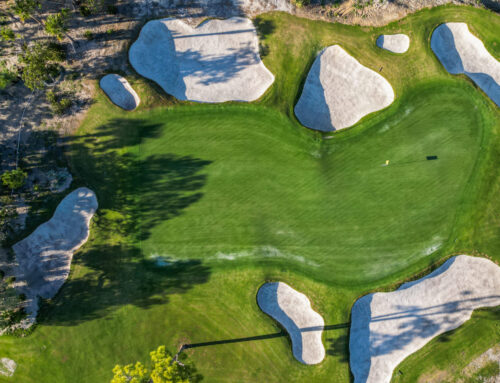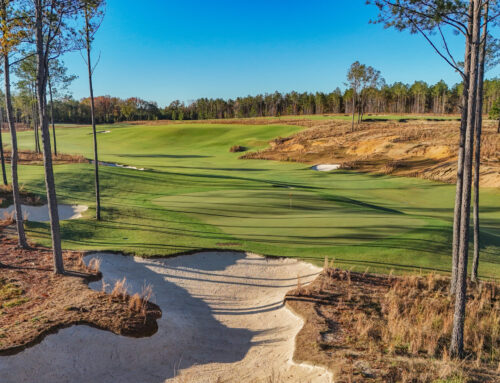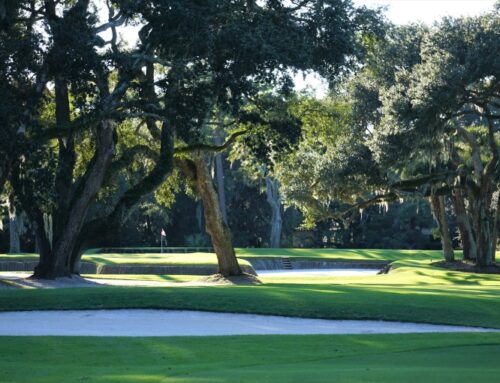Ekwanok Country Club
VT, USA

The famous 595 yard 7th hole has been part of American architecture for over a century.
Opened in 1900, Ekwanok Golf Club was the first eighteen hole golf course in the United States that stood favorable comparison with some of the famous courses in the United Kingdom. Up until then, golf course architecture in the United States consisted of the architect merely staking out the placement for tees, greens and bunkers. The ‘architect’ was on-site a whopping day or two and rarely stayed to see his completed work. The bunker construction and placement of hazards was therefore basic and cross bunkers were more likely to trap the weaker player than they were to dictate strategy for the better golfer. Furthermore, greens built pre-1900 in the United States were generally flat and dull. Tom Bendelow’s early work (and Bendelow was the busiest architect at the time) could be characterized in this manner before he developed more thought-provoking designs later in his career.
Despite the primitive nature of such designs at the turn of the last century, course construction was booming in the United States. In fact, the Scot Willie Dunn (son of the Willie Dunn from Musselburgh) was so busy in the last decade of the 19th century in the U.S. staking out such rudimentary courses that he sent for his nephew John Duncan Dunn to assist him. In turn, John Duncan Dunn formed a relationship with Walter J. Travis, who at the time had yet to win any of his three U.S. Amateur titles. As carefully chronicled by Bob Labbance in his book The Old Man, Travis was an intriguing character full of strong – and different – ideas on golf ranging from equipment to various swing techniques to handicapping to maintenance practices. He later founded the influential The American Golfer magazine and used it to voice his opinions.
Ekwanok was Travis’s first involvement in golf course architecture and the subject immediately fascinated him. Rather than being on site for a day or two as was typical of architects of the day, Travis frequented Ekwanok throughout the construction period and continually refined its design for many years thereafter. The on-site attention that Ekwanok received during construction helped it to stand above the vast majority of other courses being built at the time in three key aspects. First, the bunkering is placed so that the tiger golfer has to continually make smart decisions and execute for the entire length of the hole while the weaker player still has a chance. Because of his liberal use of bunkers, Travis has been accused of being a penal architect. The authors would disagree and such bunkering schemes as the one below looking down the 10th fairway is clearly more strategic than penal in nature. Travis, who was a short hitter relative to his peers, placed a premium in keeping the ball in play.
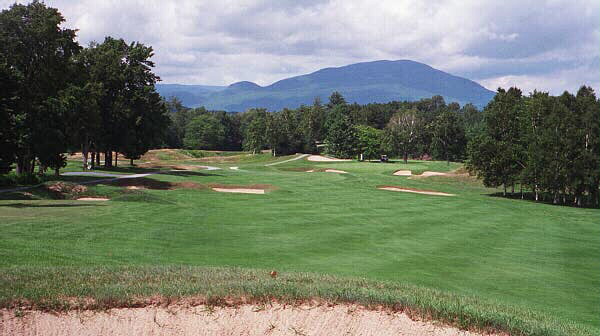
The weaker golfer can bumble his way down the 10th fairway while the better golfer has to flirt with the bunkers to gain an advantage.
Second, Ekwanok’s original greens were full of contour (e.g. the 14th green) or pitch (e.g. the 2nd green) or both. Small, tilted greens such as the right to left one found at the 2nd offer only a few hole locations to this day, given its pitch. (Note: H.C. Leeds shared this same philosophy with Travis and was building similarly pitched greens at the same time at the Myopia Hunt Club (e.g. the 4th, 6th, and 8th greens) on Boston’s North Shore).
Third, the routing was more imaginative than the typical out and back kind found overseas. Never do more than two holes head in the same direction. Instead, the routing at Ekwanok forms a ‘T’ with six holes making the stem and the balance of the holes beautifully laid across more rugged New England terrain. From the day it opened in 1900, Travis held Ekwanok in the highest esteem and was vocal in his praise. The United States Golf Association evidently agreed with his assessment and in 1914, the US. Amateur was held at Ekwanok with Francis Ouimet emerging as the popular victor.
Holes to Note
First hole, 420 yards; Ekwanok was always meant to be a serious test and it measured over 6,000 yards long the day it opened, which was a full 500 yards longer than many courses being built at the time. And the first is a quick introduction to the fact that Ekwanok is more than just a holiday course with Dunn and Travis beautifully incorporated a ditch as a diagonal hazard down the right side of the fairway.

The sundail behind the 1st tee (which is beside the 18th green) reminds all golfers that a round should take no more than three hours.
Fifth hole, 380 yards; The low profile green complex at the top of a gradual incline makes the hole with a left hand bunker ten yards shy of the green creating genuine depth perception problems. Rarely does an approach shot carry past the hole, which is a shame as such putts are often the easier ones on the green.
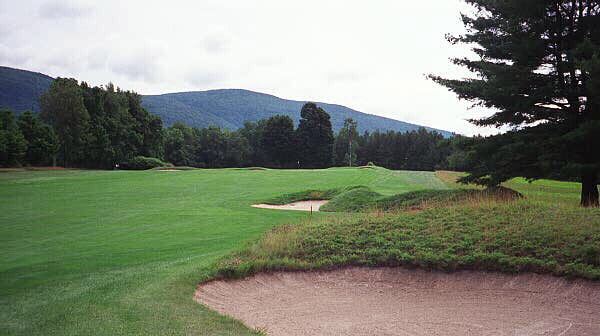
Bruce Hepner has restored many of the fairway bunkers to their original rugged appearance. In addition, he edged the top bunker above more into the 5th fairway.
Sixth hole, 190 yards; Dunn and Travis originally created a punchbowl green thirty yards to the left of today’s green. In the 1960s, Geoffrey Cornish relocated the green to the knob where it presently sits. Whether this was done for drainage/agronomic reasons or not is unclear but there is no denying that today’s present green location in a pocket of white birch trees is most attractive. The authors have seen little of Cornish’s work but it is hard to imagine that he has created better green contours than here as the green cascades down from its high back right corner to the lower left one, affording numerous interesting hole locations. More than one golfer has appeared foolish as he watches his first putt roll off the left side of the green.
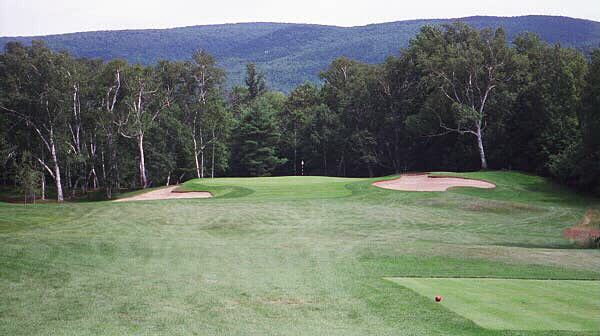
As attractive as the green’s location is amongst the white birch trees, the green contours make the hole.
Seventh hole, 595 yards; Certainly the most famous golf hole in Vermont and perhaps in New England, the monster 7th exemplifies how architecture has changed over the decades. At the time, Dunn and Travis worked with the land and the result is a uniquely memorable hole with a hill that bisects the fairway from the 300 to 370 yard mark. Conversely, the vast majority of architects today would make the land fit the hole by dynamiting the 60 foot hill into oblivion. While the 7th is no longer the absolute terror that it once was (a good player is likely to hit 3 wood off the tee into the bowled fairway, a 4 iron over the hill, and a 7 iron onto the green), the golfer must still bear down on all three shots, a trait often found wanting in most three shot holes built after World War II.
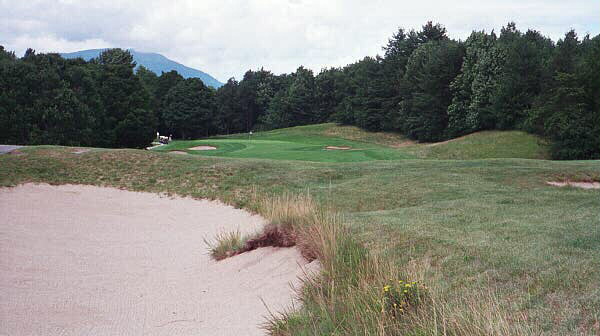
The view from on top the hill that bisects the 7th fairway. The golfer still has over 250 yards to go.
Eighth hole, 340 yards; An interesting hole in that there is no clear way to play it. The golfer can blast a driver long down the right hand side in hopes of minimizing the hill on the left and gaining a flat lie. Of course, just in the right rough at the 250 yard mark is a recently restored menacing bunker. Conversely, the more the golfer edges away from that bunker, and takes the more direct route to the hole, the more likely he is to encounter an uneven lie from the shoulder of the hill that dominates the play on the 7th. Cornish suggested that this green should have two distinct tiers and such plans were carried out in the 1960s.
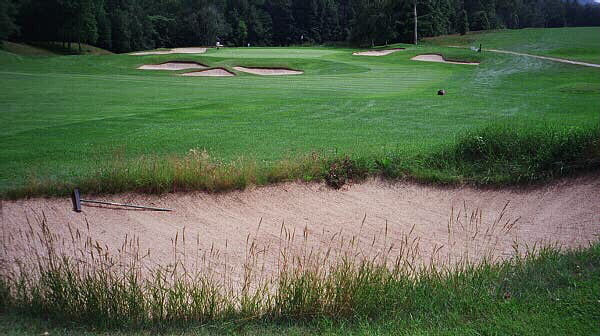
The right side of the 8th fairway is relatively flat but the golfer must take care to miss this bunker.
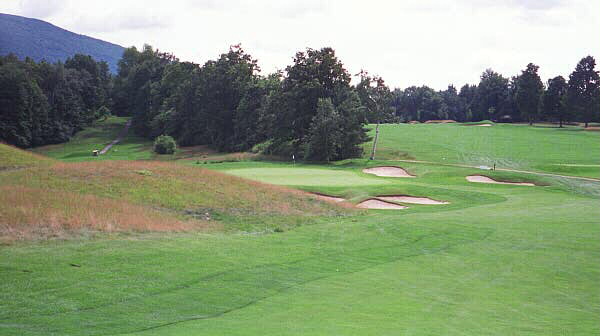
Conversely, the left side of the fairway is more humpy and part of the green is obscured. Interestingly enough, this hole has as much bend in it as any hole on the course: most holes built around the turn of the century were essentially straight.
Twelfth hole, 375 yards; A year after Ekwanok opened, Travis was afforded the luxury of going to the United Kingdom and playing/studying numerous of their most famous courses. Though Travis wasn’t a popular figure with the Brits during much of his playing career, he was quite taken by how the links holes used the land to their maximum advantage. This U.K. trip greatly influenced his design philosophy in the years to come. No doubt Dunn and Travis must have been pleased by how the rugged New England topography offered its own opportunity to create distinctive, hard to replicate holes and they seized the opportunity at the 12th.
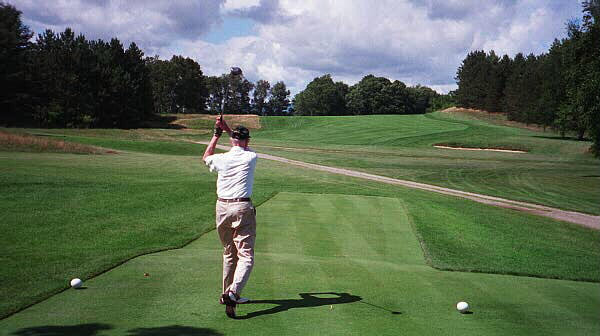
Dr. Henry Terrie hits another fairway, this time the 12th at Ekwanok.

From the crest of the hill at the 12th, the golfer faces a downhill approach to a relatively small target.
Thirteenth hole, 220 yards; A beautiful long one shotter with a sprawling bunker fifteen paces shy of the putting surface on the direct line from the back tee. However, the left side of the green is open and the left to right slope of the surrounding land encourages any ball played to the left to chase toward the green. The ground game was very much in the forefront of Travis’s mind when this hole was laid out.
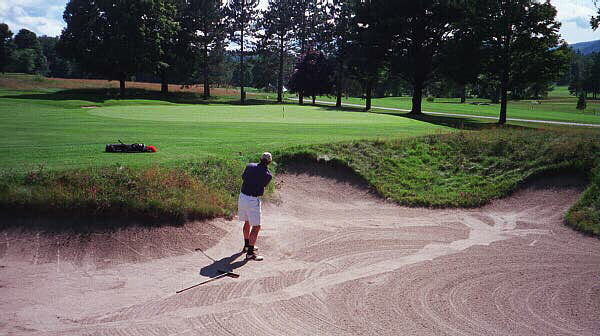
Best to avoid this bunker altogether by playing to the left and having the ball work toward the 13th green.
Fourteenth hole, 340 yards; With the dramatic 7th overshadowing all the other holes at Ekwanok, this hole has never received its just recognition as a superb short two shotter. Played from an elevated tee across broken, unkempt terrain, the fairway is on a diagonal past an array of bunkers down the left hand side. Though Travis wanted his courses to be playable for a wide range of golfers, he wasn’t reluctant to have several forced carries as seen here and at the 13th . The green is one of the best anywhere and features a severe right to left pitch at its front right corner and a swale in its left side that gathers balls into the waiting left hand greenside bunker.

Bunkers and grassy hummocks are found down the left side of the 14th fairway.
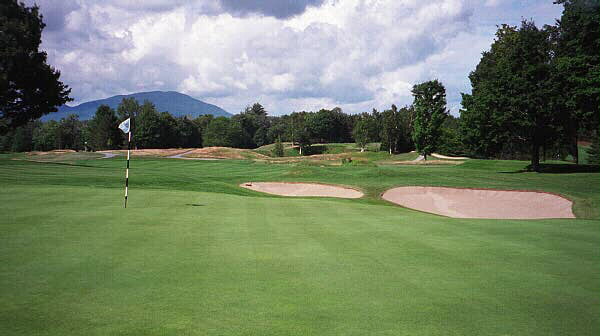
From behind the 14th green, one can see how the green funnels into the greenside bunker.
Some course critics sight the shortcoming of Ekwanok to be that holes 1-3 and 16-18 parallel each other while playing up and down the hillside that the clubhouse is located upon. While the back and forth across the field is not ideal, each of those six holes has its own merits, and each one plays uniquely to the others. For instance, the diagonal use of the stream along the 1st fairway, the sharply tilted green at the 2nd, and the stream that fronts the 3rd green provide each of those three holes with their own distinctive playing characteristics.
To the authors, the greater shame is that more of Dunn’s and Travis’s work does not remain. Only a few of the greens are original and many of the bunkers have been removed and/or made shallower. Ekwanok’s membership evidently may not view ladders leading into certain bunkers with the same sense of challenge/joy as Travis and Dunn did!
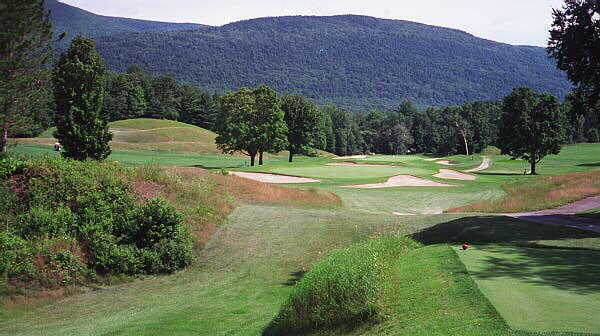
A ladder was once required to get in and out of the bunker that fronts the one shot 11th green.
Fortunately, in recent years, the Club has entrusted Bruce Hepner of Renaissance Designs to bring back some of the lost Travis/Dunn character to the course. In particular, Hepner has overseen the removal of several hundred trees, the restoration of many of the fairway bunkers to their original rugged appearance, and the promotion of more natural native grass areas. In addition, several of the more interesting hole locations have been recaptured as greens are restored to their original size.
The Club should be commended for heading in this direction. They have a course of major historical significance that is made all the more memorable and fun by the restoration of its unique features. For instance, one can only hope that more of the scar bunkering that once dominated the top of the hill that bisects the 7thfairway will replace the golf cart path that presently mars the hillside. Hopefully, the Club will continue to provide similar encouragement and support to Hepner in the months to come.
While Travis’s efforts at Garden City Golf Club and his design at Hollywood Golf Club are regarded as his finest work because of their more interesting angles of play, Travis was personally more attached to Ekwanok and this part of New England in general. Despite his hectic schedule as a world class player, course designer, and founder of The American Golfer, Travis always found time to escape to Manchester, Vermont. Indeed, he is buried nearby here and his famous Schenectady putter is proudly displayed in the clubhouse library.
Those lucky enough to play this charming course and to spend time in the area will fully appreciate why Travis fell under their spell.

With the Taconic mountain range as a backdrop, golfers have long enjoyed the charms of playing golf in this area. Note how the native fescue grasses are now being encouraged to grow at Ekwanok.
The End



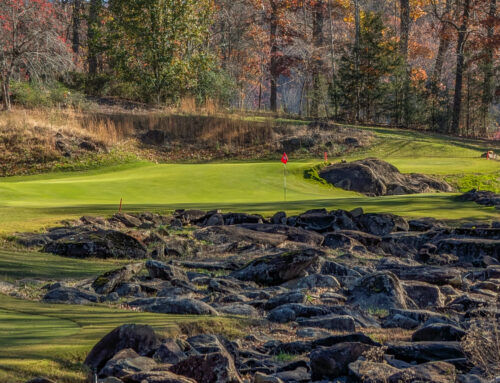
![The Park, West Palm (Lit 9) [2023]](https://golfclubatlas.com/wp-content/uploads/2024/12/IMG_7092-2-scaled-500x383.jpg)
